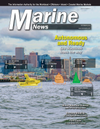
Page 22: of Marine News Magazine (October 2019)
Autonomous Workboats
Read this page in Pdf, Flash or Html5 edition of October 2019 Marine News Magazine
COLUMN WORKBOAT EQUIPMENT
Shock
Mitigation:
Size Matters
When it comes to shock-mitigation, bigger is truly better.
By Dr. Tim Rees, Ph.D.
Let’s consider a thought experiment:
You must take the wheel of one of two cars speeding along straight tracks with no exits. Both cars are traveling at 100 km/hour, but the ? rst is 100 meters from a brick wall while the second is only 10 meters from an identical wall.
There is nothing to do but decelerate before the crash, and assuming your
Rees decision is guided by self-preservation the choice is obvious. Why? Because even the best tactical driver can’t overcome physics, and even if the second car can be stopped before the wall it are among the possibilities, and in addition to endanger- must undergo severe decelerations. In fact, the second ing rigid skeletal structures, prolonged exposure can affect car can be expected to see ten times the accelerations felt circulation and rupture blood vessels. For reference sake, in the ? rst car if both are handled perfectly. We can prove astronauts sustain something like 3 to 4 g during launch, it mathematically, but you don’t need any equations to but the limits of human tolerance depend on multiple fac- appreciate just how great a luxury stopping distance is tors, including magnitude, direction and rate of change. when it comes to decelerating a moving body. We will Like force, acceleration is a vector, so direction really does return to this theme, but ? rst let’s take a look at accelera- matter, and what a person can withstand in the forwards- tion in the bigger picture. facing direction might be entirely different from what they will tolerate in the vertical.
D C With that in mind, let’s talk about impacts, and more
EFINING THE HALLENGE
As you might expect, problems of acceleration (and de- speci? cally, wave impacts involving boats on rough water. celeration) pose many dif? culties in engineering design. These impacts come in at all angles creating bursts of ac-
This is especially true in a dynamic environment. Accel- celeration. They may be erratic and unpredictable and can eration is related to force through Newton’s second law, so include rotational components. These impacts are a form it constrains design decisions. Acceleration imposes strict of mechanical shock. They are transient acceleration events limitations on safety, and under severe exposure humans exempli? ed by their abrupt onset and severity. These im- and hardware can quite literally break. Acceleration is of- pacts have pulse durations on the order of 100 millisec- ten measured in units of “g”, with 1 g equal to what is onds, which is brief in comparison to a shuttle launch, but experienced due to gravity at earth’s surface (9.8 m/s^2). the abrupt transitions in a wave slam only makes it more
The human response to acceleration is an interesting brutal. And wave slams can be surprisingly intense. For and colorful topic. G-LOC, redding-out, and greying-out military-use in fast boats testing at up to 10 g is required.
October 2019 22 MN

 21
21

 23
23
